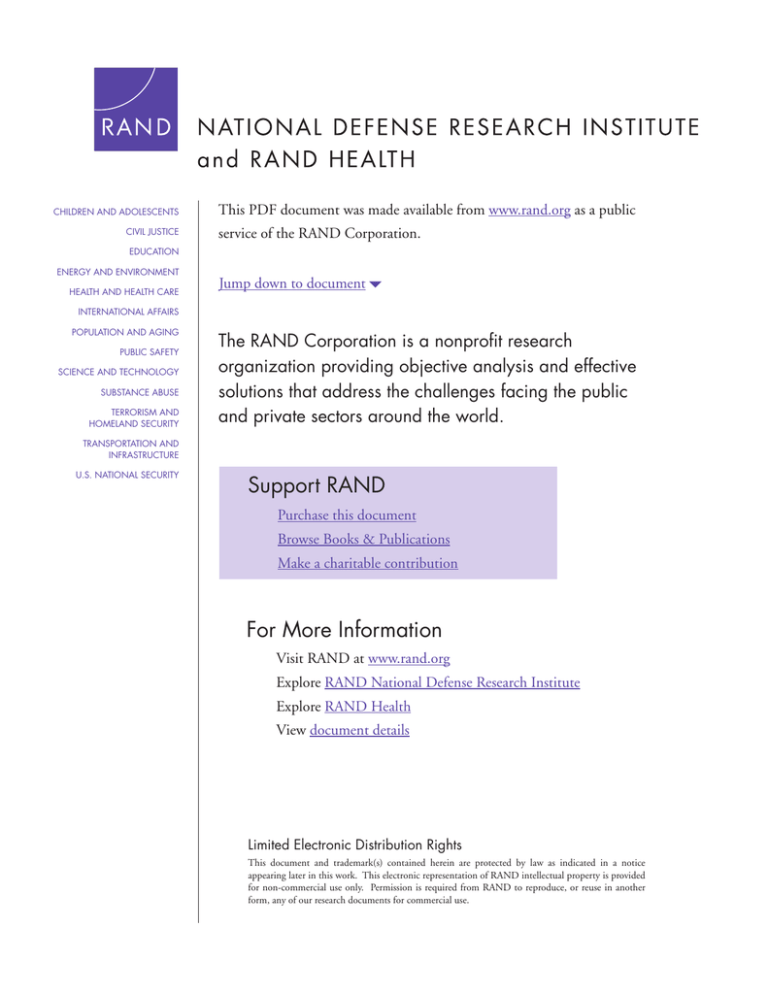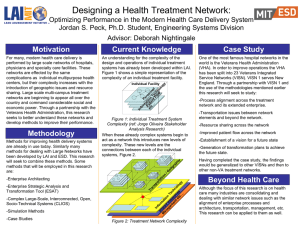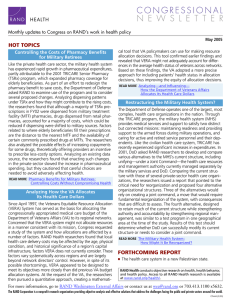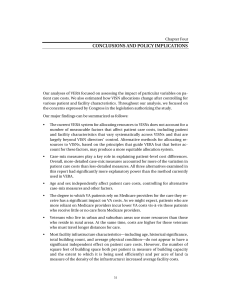6 om as a public service of the RAND Corporation.
advertisement

CHILDREN AND ADOLESCENTS CIVIL JUSTICE This PDF document was made available from www.rand.org as a public service of the RAND Corporation. EDUCATION ENERGY AND ENVIRONMENT HEALTH AND HEALTH CARE Jump down to document6 INTERNATIONAL AFFAIRS POPULATION AND AGING PUBLIC SAFETY SCIENCE AND TECHNOLOGY SUBSTANCE ABUSE TERRORISM AND HOMELAND SECURITY The RAND Corporation is a nonprofit research organization providing objective analysis and effective solutions that address the challenges facing the public and private sectors around the world. TRANSPORTATION AND INFRASTRUCTURE U.S. NATIONAL SECURITY Support RAND Purchase this document Browse Books & Publications Make a charitable contribution For More Information Visit RAND at www.rand.org Explore RAND National Defense Research Institute Explore RAND Health View document details Limited Electronic Distribution Rights This document and trademark(s) contained herein are protected by law as indicated in a notice appearing later in this work. This electronic representation of RAND intellectual property is provided for non-commercial use only. Permission is required from RAND to reproduce, or reuse in another form, any of our research documents for commercial use. This product is part of the RAND Corporation monograph series. RAND monographs present major research findings that address the challenges facing the public and private sectors. All RAND monographs undergo rigorous peer review to ensure high standards for research quality and objectivity. Understanding Potential Changes to the Veterans Equitable Resource Allocation (VERA) System A Regression-Based Approach Jeffrey Wasserman Jeanne Ringel Karen Ricci Jesse Malkin Barbara Wynn Jack Zwanziger Sydne Newberry Marika Suttorp Afshin Rastegar Prepared for the Department of Veterans Affairs Approved for public release; distribution unlimited The research described in this report was sponsored by the Department of Veterans Affairs (DVA). The research was conducted jointly by RAND Health’s Center for Military Health Policy Research and the Forces and Resources Policy Center of RAND’s National Defense Research Institute, a federally funded research and development center supported by the Office of the Secretary of Defense, the Joint Staff, the unified commands, and the defense agencies under Contract DASW01-01-C-0004. Library of Congress Cataloging-in-Publication Data Understanding potential changes to the Veterans Equitable Resource Allocation System (VERA) : a regression-based approach / Jeffrey Wasserman ... [et al.]. p. cm. “MG-163.” Includes bibliographical references. ISBN 0-8330-3560-6 (pbk. : alk. paper) 1. Veterans—Medical care—United States. 2. Veterans Equitable Resource Allocation System. I. Wasserman, Jeffrey. UB369.U5 2004 362.1'086'970973—dc22 2004001845 The RAND Corporation is a nonprofit research organization providing objective analysis and effective solutions that address the challenges facing the public and private sectors around the world. RAND’s publications do not necessarily reflect the opinions of its research clients and sponsors. R® is a registered trademark. © Copyright 2004 RAND Corporation All rights reserved. No part of this book may be reproduced in any form by any electronic or mechanical means (including photocopying, recording, or information storage and retrieval) without permission in writing from RAND. Published 2004 by the RAND Corporation 1700 Main Street, P.O. Box 2138, Santa Monica, CA 90407-2138 1200 South Hayes Street, Arlington, VA 22202-5050 201 North Craig Street, Suite 202, Pittsburgh, PA 15213-1516 RAND URL: http://www.rand.org/ To order RAND documents or to obtain additional information, contact Distribution Services: Telephone: (310) 451-7002; Fax: (310) 451-6915; Email: order@rand.org Summary Background and Approach The Veterans Equitable Resource Allocation (VERA) system was instituted by the Veterans Health Administration (VHA) in 1997 in a continuing effort to improve the allocation of congressionally appropriated health care funds to the 21 Veterans Integrated Service Networks (VISNs).1 VERA was designed to ensure that funds are allocated in an equitable, comprehensible, and efficient manner and to address the complexities of providing health care to veterans with service-connected disabilities, low incomes, and special health care needs. In contrast to earlier VHA allocation systems, which were based largely on historical costs, VERA bases its allocation of funds primarily on the number of veterans served (workload). However, the veteran population has been shifting dramatically from some geographic areas to others. As a result, since the implementation of VERA, allocations to the VISNs have undergone similar shifts, from areas with shrinking veteran populations to areas with increasing numbers of veterans. These funding shifts prompted concerns in Congress that VERA was not distributing resources equitably across the VISNs, which could affect health care delivery to some veterans. In legislation enacted in late 2000 (Public Law No. 106-377), Congress directed the Department of Veterans Affairs (VA) to determine “whether VERA may lead to a distribution of funds that does not cover the special needs of some veterans.” The VHA contracted with the RAND National Defense Research Institute to examine three specific areas of concern expressed by Congress: • The extent to which allocations cover costs associated with maintaining older-thanaverage medical facilities, caring for populations with complex case mixes, facilities undergoing major consolidation, and/or rural versus urban location. • Issues associated with maintaining affiliations between the VA medical centers and academic medical centers. • The extent to which weather differences influence costs. To address these issues within the allotted time, the NDRI initially conducted a qualitative analysis of the VERA system. Based on our review of the literature and interviews, we concluded that VERA appeared to meet its objectives of improving the allocation of resources to meet the geographical distribution of veterans as well as improving the incentive ____________ 1 These VISNs span the United States, its territories, and the Philippines. In fiscal year (FY) 2002, the number of VISNs was reduced from 22 to 21 (VISNs 13 and 14 were combined to become VISN 23). xiii xiv Understanding Potential Changes to the Veterans Equitable Resource Allocation (VERA) System structure, fairness, and simplicity of the allocation methodology. We also found that the influence of several factors of concern to Congress on the costs of providing health care to veterans—the number of buildings, services offered, rural (versus urban) location, and extremes of weather—was unclear, or, in the case of weather extremes, not important. In contrast, we identified several factors that appeared to exert a predictable and systematic influence on veterans’ health care costs. These factors included patient case mix and the presence or absence of facility affiliations with medical schools (findings from that analysis appear in the report An Analysis of the Veterans Equitable Resource Allocation (VERA) System [Wasserman et al., 2001]). However, the Phase I report also concluded that comprehensive evaluation of the current system, and of possible modifications to it, required extensive quantitative analysis. At the request of Congress, we undertook a quantitative analysis of the VERA system (Phase II) to assess how a variety of patient, facility, and community characteristics affected costs of patient care; to create a model to assess the impact of a wide range of policy changes; and to simulate how such policy changes would affect VISN allocations. Our approach was to create multivariate regression models that included factors that might lead to differences in patient costs. One such model, the “all variables model” (AVM), included all variables we could identify that might influence differences in patient costs. Another model, the “selected variables model” (SVM), included only variables that showed a significant effect in our first model, that were consistent with the VA mission, and that were largely outside the control of VISN directors. Factors that were found to have a major influence on costs included patient case-mix measures, patient reliance on Medicare for coverage of health care, and a small number of facility variables. Based on these findings, we recommended that the VA consider modifying VERA to take greater account of patient and facility characteristics than it did. One mechanism for doing so would be to adopt an allocation system that relies on a regression/simulation framework similar to the one used in the Phase II analysis. However, before implementing such an allocation system, we recommended conducting additional analyses to gain a better understanding of how particular variables influence VISN allocations. After examining the results of this second phase of research, Congress and the VHA requested that NDRI conduct a set of additional analyses. The goals of Phase III were to determine how particular patient and facility characteristics influence allocations to VISNs and to simplify and refine the models created in Phase II to reflect policy changes and more recent data. One such policy change was the fiscal year (FY) 2003 modification of VERA’s case-mix adjustment mechanism from three categories (VERA-3) to ten categories (VERA10). Our approach was similar to that of Phase II, with several important differences: • We used more recent data sets to estimate costs and to simulate VISN allocations. • We simplified our modeling approach substantially by collapsing the patient- and facility-level equations into a single-equation model without sacrificing the power of our original two-equation model to explain and predict costs. • To generate additional insights into our simulated VISN allocations, we disaggregated the results to show the influence of each variable included in the models on VISN allocations. Using our regression equation, we constructed three types of models, with three distinct objectives. Summary xv Our first model, the “base regression model” (BRM), was intended to demonstrate how a regression-based approach for calculating VISN allocations compares with the method that the VA currently uses to arrive at the allocations. The BRM included only those variables that reflect the current types of adjustments that the VA takes into account in determining VISN allocations: a ten-group case-mix-adjustment measure, an index that measures geographic variation in the costs of labor inputs used to provide patient care, and measures for teaching intensity and research costs. The second model, the all variables model (mentioned above), was designed to account for all patient, facility, and community variables that had been shown to influence the costs of treating veterans at VA health care facilities and that could be measured using readily available data sets. Our third type of model, the selected variables model (mentioned above), included all of the variables found in the BRM, as well as some additional measures of patient and facility characteristics that were included in the AVM—that is, variables that were found to influence the costs of care and that might be appropriate to use for policy purposes. Only the findings for the SVM are summarized here. In addition, to further assess the effects of case-mix measure, we compared the effects of the models using the VERA-10 case-mix measure with those using a more refined casemix adjustment—VA diagnostic cost groups (DCGs).2 Findings Regression Results Six patient-level variables played key roles in explaining an individual’s use of VA resources: • Similar to the findings of the Phase II report, gender and age independently affected patient care costs when we controlled for case-mix and other factors. However, patients who were older than 85 had lower costs. • Health status played a significant role in determining health costs. • When VERA-10 was used as the adjustment for health status, patients residing in areas with greater concentrations of physicians and hospital beds incurred significantly higher health costs than those residing in areas with lower concentrations of health care providers. • Patients who traveled a greater distance to receive their health care have higher costs. • Greater Medicare reliance was associated with lower VA health costs. A small number of facility-level characteristics also influenced individuals’ use of VA health care resources: ____________ 2 The VA DCGs are a modification of the standard DCGs that reflect differences between the veteran population and the privately insured population, for which off-the-shelf DCGs software is intended. Specifically, the VA combined 30 highestranked condition categories (HCCs) (those that are very uncommon in the VA population or do not predict significant positive costs) into one category and added 14 VERA category flags for special disability programs (e.g., spinal cord injury, traumatic brain injury, and serious mental illness). The VA then predicted the costs for each patient from the HCC model and assigned patients to one of 24 “VA DCGs” categories based on their predicted costs (VHA, 2001). In our equations that use DCGs, one dichotomous variable was included for each VA DCG except the lowest-cost VA DCG, which served as the reference group. xvi Understanding Potential Changes to the Veterans Equitable Resource Allocation (VERA) System • VISN labor index, research costs per patient, and square feet of building space per patient had positive influences on costs; that is, they increased costs independently of the case-mix measure used. • In contrast, for two variables in the SVM—number of residents per full-time physician and square feet of building space per acre of land—the direction of the association with costs depended on which health status measure was included in the model. When the VERA-10 measure was used, the number of residents per full-time physician had a positive effect on patient costs, but when the VA DCGs was used as the case-mix measure, it had a negative effect. Similarly, the square feet of building space per acre of land was positively associated with costs when VA-DCGs was the casemix measure, but it was insignificant under VERA-10. Simulation Results The results from the BRM and SVM regression models were used to simulate VISN allocations. To interpret the simulation results, we made three types of comparisons. First, we compared actual FY 2003 allocations to the simulated allocations from the BRM, to isolate the effect of the difference between the actual VERA methodology and the regression-based methodology. Second, we compared the VERA-10 SVM allocations with the BRM allocations. Finally, we compared the VERA-10 SVM allocations with the VA DCG SVM allocations. We found that recent VERA policy changes—including the introduction of the VERA-10 case-mix adjustment and the manner in which high-cost cases (i.e., those with costs of $70,000 or more) are treated under VERA—have reduced differences in the ways funds are allocated under the current VERA system compared with the regression-based approach. For example, in FY 2002, applying the regression-based approach—in particular, the VERA-10 SVM—would have redistributed 2.9 percent of the total actual allocation. However, in FY 2003, the regression-based approach with VERA-10 would have redistributed only 1.2 percent of the funds. VA DCGs would lead to a slightly larger redistribution (i.e., 1.8 percent of the total allocation). Disaggregation Results The disaggregation analysis compared the simulated allocation when each patient was assigned the average value for each characteristic (the “unadjusted average allocation”) with the simulated allocation that occurs when a characteristic of interest (e.g., health status) was allowed to take its true value. The results can be viewed in two ways: from the VISN perspective and from the national perspective. Viewing the results from the VISN perspective shows how each variable helps to move a particular VISN from the unadjusted average, or workload-based, allocation to the simulated allocations from the SVM. Viewing the results from the national perspective shows the factors that are most important in affecting allocations nationwide. In general, there was a great deal of correspondence across case-mix specifications in terms of which variables appeared to move the most money around. In fact, the five variables that moved the most money around were the same, regardless of which case-mix measure was included in the model, although the order differed slightly between measures: health status, research costs per unique patient, the VA labor in- Summary xvii dex, Medicare reliance, and the square feet of building space per patient. In both case-mix specifications, the amount of money redistributed by the health status measure far exceeded the amount redistributed by any other variable. The current VA system already adjusts for the top three money movers: health status, research costs, and geographic differences in labor costs. Conclusions and Policy Implications In general, the findings of this Phase III analysis were similar to those of Phase II. A key conclusion from both the results presented in this report and those of the Phase II analysis is that case mix is critical in explaining differences in patients’ costs and that it varies across VISNs. In Wasserman et al., 2003, we recommended that the VA adopt a more refined case-mix-adjustment methodology—either VERA-10 or VA DCGs—than the one it had used since VERA’s inception, which relied on only three categories. Subsequently, the VA adopted the VERA-10 case-mix measure. We applaud this decision, as we believe that it will lead to a more efficient and equitable division of health care resources. What is less clear, however, is whether VERA could be further improved by moving from VERA-10 to VA DCGs. On the one hand, VA DCGs better explain patient-level cost variation than does VERA-10. On the other hand, we observed that the VA DCGs would shift a substantial amount of money across VISNs, and we know little about why such redistributions would occur. As we found in the Phase II analysis, Medicare reliance continues to have a statistically significant effect on the costs of treating veterans at VA facilities. Specifically, as one might expect, the greater the degree to which individuals rely on Medicare, the lower their VA costs. Consequently, we believe that the VA should consider modifying VISN allocations to adjust for differences in the degree to which VA patients rely on Medicare providers for the care they receive. Doing so would help make the VERA system more equitable and efficient. However, prior to implementing a Medicare reliance adjustment, we believe that the VA should investigate the accuracy with which Medicare data, which necessarily lag the VA data by a year, predict future Medicare expenditures. Finally, in both this and the Phase II report, we used regression analysis to understand the extent to which a wide range of variables influences the costs of caring for VA patients. We believe that regression analysis holds great potential for serving as a mechanism for the VA to determine VISN-level allocations. However, we do not believe that it is critical at this juncture to shift to a regression-based allocation approach. The primary reason we advocate against such a transition at this point is that such a change would be difficult to implement, and the current allocation approach comes very close to the regression-based one, as evidenced by the low percentage of funds that the latter would redistribute. In the event that the VA elects to adjust VISN allocations for a wider range of variables—including, for example, Medicare reliance and some of the other factors that the disaggregation analysis demonstrated were responsible for shifting funds across VISNs—then adopting a regression-based approach might prove to be advantageous. Even if the VA does not switch to a regression-based methodology, the use of regression analysis can provide a powerful management tool for VA headquarters staff and VISN directors. The single-equation approach upon which this study relied is easy to use and in- xviii Understanding Potential Changes to the Veterans Equitable Resource Allocation (VERA) System terpret. The output from the regression models can be used to identify additional potential adjustments to VERA, inform decisions regarding requests for supplemental funds, and provide guidance for VISN directors in determining how funds should be allocated to facilities within their networks.






